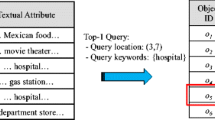Abstract
Orthogonal region query has always been an important topic in the field of database query, geographic information system, computer graphics, data mining and multimedia information retrieval. In recent years, the “Why-Not” questions has gradually become a hot topic in the SQL query, Skyline query, and spatial keyword Top-K query. However, no one has answered the “Why-Not” questions of the orthogonal region Top-K query. Based on the in-depth study of the orthogonal region Top-K query algorithm, this paper first proposes to answer the “Why-Not” questions in the orthogonal region Top-K query. We adjust the initial query so that the result set of the new query contains the “Why-Not” elements with the least cost. Abundant experiments have been conducted to analyze the proposed algorithm on the factors of initial k value, initial rank, and data size. The experimental results demonstrate the accuracy and efficiency of the proposed algorithm.













Similar content being viewed by others
References
Afshani P, Brodal G, Zeh N (2011) Ordered and unordered top-k range reporting in large data sets. Proc Ann ACM-SIAM Symp Discrete Algorithms. United States : Association for Computing Machinery: 390–400
Bhowmick SS, Sun A, Truong BQ (2013) Why Not, WINE?: Towards answering why-not questions in social image search. MM '13 Proc 21st ACM Int Conf Multimed. New York, NY, USA: ACM: 917–926
Bhowmick SS, Sun A, Truong BQ (2014) Why Not, WINE?. WWW '14 Companion Proceedings of the 23rd International Conference on World Wide Web. New York, NY, USA: ACM: 83–86
Brodal G, Fagerberg R, Greve M et al. (2009) Online sorted range reporting. Algorithms and Computation. Proceedings 20th International Symposium. ISAAC 2009. Berlin Germany: Springer Verlag: 173~182
Buneman P, Tan W-C (2007) Provenance in databases. SIGMOD '07 Proceedings of the 2007 ACM SIGMOD international conference on Management of data. New York, NY, USA: ACM: 1171–1173
Chapman A, Jagadish HV (2009) Why not? in: SIGMOD '09 Proceedings of the 2009 ACM SIGMOD International Conference on Management of data. New York, NY, USA: ACM: 523–534
Chen L, Lin X, Hu H et al. (2015) Answering Why-not question on spatial keyword Top-K queries. 2015 IEEE 31st Int Conf Data Eng. Piscataway USA: IEEE: 279–290
de Berg M, van Kreveld M, Overmars M et al (2000) Computational geometry. Springer Berlin Heidelberg, Berlin Germany, pp 95–120
Gao Y, Liu Q, Chen G et al (2015) Answering Why-not questions on reverse top-k queries. Proc VLDB Endow 8(7):738–749
He Z, Lo E (2012) Answering why-not questions on top-k queries. 2012 IEEE 28th Int Conf Data Eng. Washington: IEEE: 750–761
Herschel M (2013) Wondering why data are missing from query results?: ask conseil why-not. CIKM '13 Proc 22nd ACM Int Conf Inform Knowledge Manag. New York, NY, USA: ACM, . 2213–2218
Herschel M (2015) A hybrid approach to answering why-not questions on relational query results. J Data Inform Quality - Special Issue Provenance, Data Inform Qual 5(3):10–23
Herschel M, Hern’andez MA (2010) Explaining missing answers to SPJUA queries. Proc VLDB Endow 3(1–2):185–196
Huang J, Chen T, Doan A et al (2008) On the provenance of non-answers to queries over extracted data. Proc VLDB Endow 1(1):736–747
Ilyas I, Beskales G, Soliman M (2008) A survey of top-k query processing techniques in relational database systems. ACM Comput Surv 40(4):11 1~58
Jagadish H, Chapman A, Elkiss A et al. (2007) Making database systems usable. SIGMOD ‘07 Proceedings of the 2007 ACM SIGMOD international conference on Management of data. New York, NY, USA: ACM: 13–24
Sheng C, Tao Y (2012) Dynamic top-k range reporting in external memory. Proc ACM SIGACT-SIGMOD-SIGART Sym Principles Database Syst. United States: Assoc Comput Mach: 121–130
Tran QT, Chan C-Y (2010) How to ConQueR Why-not Questions. SIGMOD '10 Proceedings of the 2010 ACM SIGMOD International Conference on Management of data. New York, NY, USA: ACM: 15–26
Acknowledgements
This work was supported by National Natural Science Fund of China under grants 61572215.
Author information
Authors and Affiliations
Corresponding author
Additional information
Publisher’s Note
Springer Nature remains neutral with regard to jurisdictional claims in published maps and institutional affiliations.
Rights and permissions
About this article
Cite this article
Li, G., Sun, P., Yuan, L. et al. Research on why-not questions of top-K query in orthogonal region. Multimed Tools Appl 78, 30197–30219 (2019). https://doi.org/10.1007/s11042-018-6920-6
Received:
Revised:
Accepted:
Published:
Issue Date:
DOI: https://doi.org/10.1007/s11042-018-6920-6




